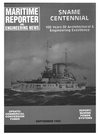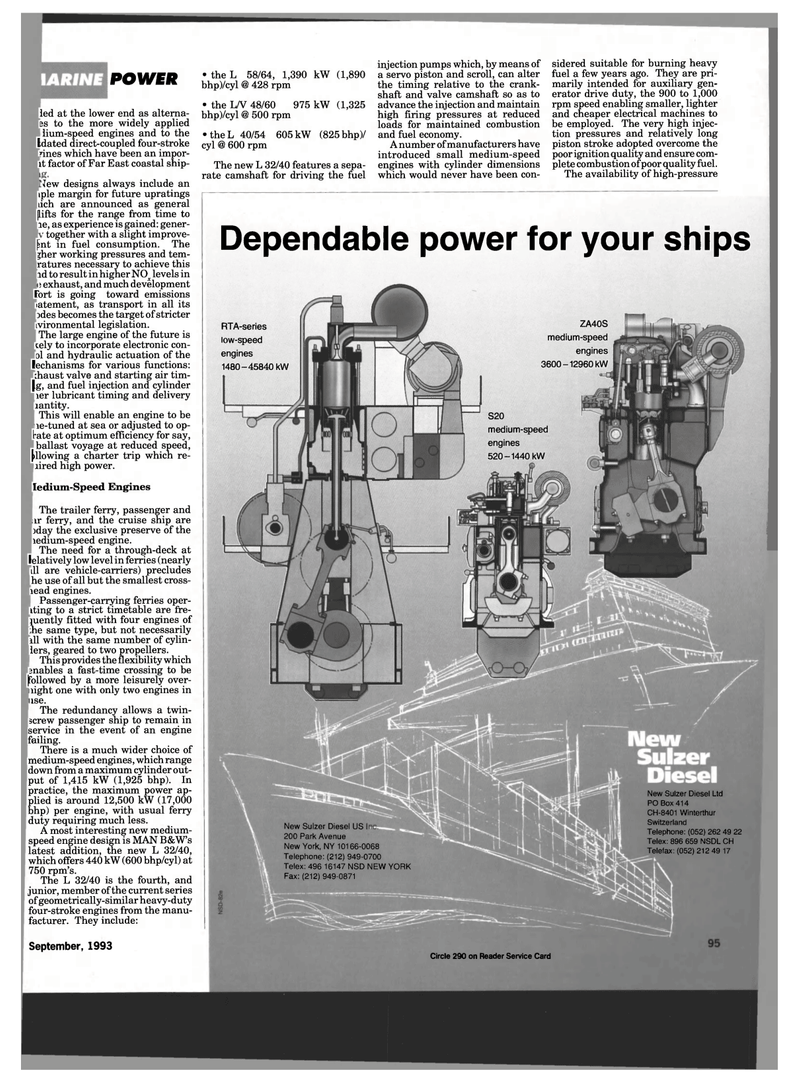
Page 101: of Maritime Reporter Magazine (September 1993)
Read this page in Pdf, Flash or Html5 edition of September 1993 Maritime Reporter Magazine
POWER led at the lower end as alterna-
BS to the more widely applied lium-speed engines and to the
Idated direct-coupled four-stroke *ines which have been an impor- lt factor of Far East coastal ship-
Jew designs always include an iple margin for future upratings dch are announced as general [lifts for the range from time to ie, as experience is gained: gener- ' together with a slight improve- pnt in fuel consumption. The jher working pressures and tem- ratures necessary to achieve this id to result in higher NOx levels in ; exhaust, and much development
Fort is going toward emissions latement, as transport in all its ades becomes the target of stricter
Lvironmental legislation.
The large engine of the future is tely to incorporate electronic con- ol and hydraulic actuation of the lechanisms for various functions: :haust valve and starting air tim-
Jg, and fuel injection and cylinder ler lubricant timing and delivery lantity.
This will enable an engine to be le-tuned at sea or adjusted to op- bate at optimum efficiency for say, ballast voyage at reduced speed, |>llowing a charter trip which re- lired high power. ledium-Speed Engines
The trailer ferry, passenger and lr ferry, and the cruise ship are )day the exclusive preserve of the ledium-speed engine.
The need for a through-deck at lelatively low level in ferries (nearly ill are vehicle-carriers) precludes he use of all but the smallest cross- lead engines.
Passenger-carrying ferries oper- iting to a strict timetable are fre- quently fitted with four engines of ;he same type, but not necessarily ill with the same number of cylin- lers, geared to two propellers.
This provides the flexibility which enables a fast-time crossing to be followed by a more leisurely over- light one with only two engines in lse.
The redundancy allows a twin- screw passenger ship to remain in service in the event of an engine failing.
There is a much wider choice of medium-speed engines, which range down from a maximum cylinder out- put of 1,415 kW (1,925 bhp). In practice, the maximum power ap- plied is around 12,500 kW (17,000 bhp) per engine, with usual ferry duty requiring much less.
A most interesting new medium- speed engine design is MAN B&W's latest addition, the new L 32/40, which offers 440 kW (600 bhp/cyl) at 750 rpm's.
The L 32/40 is the fourth, and junior, member of the current series of geometrically-similar heavy-duty four-stroke engines from the manu- facturer. They include:
September, 1993 • the L 58/64, 1,390 kW (1,890 bhp)/cyl @ 428 rpm • the L/V 48/60 975 kW (1,325 bhp)/cyl @ 500 rpm •theL 40/54 605 kW (825 bhp)/ cyl @ 600 rpm
The new L 32/40 features a sepa- rate camshaft for driving the fuel injection pumps which, by means of a servo piston and scroll, can alter the timing relative to the crank- shaft and valve camshaft so as to advance the injection and maintain high firing pressures at reduced loads for maintained combustion and fuel economy.
A number of manufacturers have introduced small medium-speed engines with cylinder dimensions which would never have been con- sidered suitable for burning heavy fuel a few years ago. They are pri- marily intended for auxiliary gen- erator drive duty, the 900 to 1,000 rpm speed enabling smaller, lighter and cheaper electrical machines to be employed. The very high injec- tion pressures and relatively long piston stroke adopted overcome the poor ignition quality and ensure com- plete combustion of poor quality fuel.
The availability of high-pressure
Dependable power for your ships
RTA-series low-speed engines 1480-45840 kW
ZA40S medium-speed engines 3600-12960 kW
S20 medium-speed engines 520-1440 kW
New Sulzer Diesel US I 200 Park Avenue
New York, NY 10166-0068
Telephone: (212) 949-0700
Telex: 496 16147 NSD NEW YORK
Fax: (212) 949-0871
New Sulzer Diesel Ltd
PO Box 414
CH-8401 Winterthur
Switzerland
Telephone: (052) 262 49 22
Telex: 896 659 NSDL CH
Telefax: (052) 212 49 17
Circle 290 on Reader Service Card

 100
100

 102
102
